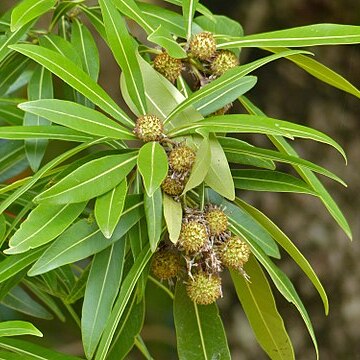Infructescence a head of capsules, each with hard endocarp splitting into 4, the apical part and calyx remnants usually attached to a central axis formed from the septum of the ovary, the axis later detaching from the receptacle.
Inflorescences lateral, the axes usually unbranched; nodes with strongly cohering stipules modified into circumscissile calyptra-like bracts surrounding the young inflorescence; true peduncle elongating, glabrous or pubescent.
Ovary 2-locular; placentas shortly obovoid, attached to the upper third of the septum; ovules 2–5 per loculus, pendulous; style exserted, pollen presenter clavate with receptive area in distal part.
Leaves in whorls of 3 or 4, petiolate, with or without domatia in the axils of the nerves; stipules narrowly triangular, deciduous.
Calyx tubes free from each other; limb-tube developed, densely hairy outside, slightly pubescent inside; lobes oblong.
Flowers 5-merous, subsessile on the densely pubescent receptacle separated by numerous spathulate bracteoles.
Stamens inserted in the throat, exserted; anthers basifixed, introrse; filaments short, glabrous.
Corolla tube hypocrateriform; lobes oblong, imbricate.
Seeds ovoid, bilaterally compressed, not winged.
Terminal vegetative buds conical.
Small to medium sized trees.

